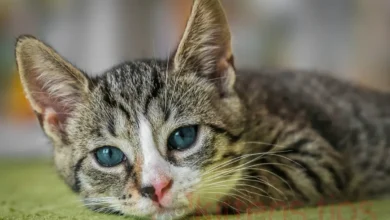
The lack of stability of the cat on its hind legs. 5 possible causes
The lack of stability of the cat on its hind legs can be a cause for concern for the owner, but it could also be a superficial issue that resolves on its own. A superficial problem may arise when you are certain that the cat has had a minor injury to the hind legs or has recently undergone injectable treatment in the upper area of the hind legs. In these cases, it is very possible for the cat to experience instability on its hind legs and exhibit an abnormal gait.
However, there can also be more serious issues causing the lack of stability in the cat’s hind legs. Urgent specialized investigations are recommended by a veterinarian if the cause of this “anomaly” is unknown to you.
Table of Contents
The lack of stability of the cat on its hind legs. 5 possible causes
If a cat is having trouble maintaining stability on its hind legs, the causes can be varied. The most common reasons for this instability include:
Injuries or Trauma
Cats can sustain injuries to the spine or hind legs due to accidents, falls, or strong impacts. These injuries may affect nerves or bone structures, causing a loss of stability, especially in the hind legs.
Issues with the Nervous System
Conditions such as diabetic neuropathy (a complication of diabetes in cats), spinal thrombosis (the formation of a blood clot in the spinal cord), brain tumors, or spinal cord injuries can interfere with nerve signals and muscular control, leading to coordination and stability difficulties.
Degenerative Diseases Causing Lack of Stability
Degenerative diseases causing the lack of stability of the cat on its hind legs encompass various conditions, including spondylosis (the formation of bony outgrowths around the vertebrae), hip dysplasia (an abnormality in hip joint development), or osteoarthritis (joint degradation). These conditions impact a cat’s joints and spine, leading to instability and presenting challenges in maintaining balance during movement.
Infections or Inflammations
Infections or inflammations in the spinal cord can affect the cat’s central nervous system, including the nerves responsible for controlling the hind legs. These conditions can cause a loss of stability and coordination.
Balance Problems
Vestibular syndrome is a condition affecting the inner ear’s vestibular system, responsible for balance. This condition can lead to instability, falls, or involuntary eye movements. Balance disorders can also be caused by other conditions, such as inner ear infections or tumors.
These are just a few of the main causes that can affect a cat’s stability on its hind legs and lead to faulty coordination of movements. A correct diagnosis requires specialized medical evaluation by a veterinarian.
Must read: Ataxia in Cats. Causes, Symptoms, and Treatmen
Depending on the established diagnosis, the veterinarian may recommend additional tests, such as X-rays, blood tests, or advanced imaging, to confirm the exact cause and plan appropriate treatment.
In conclusion, the various causes leading to the lack of stability of the cat on its hind legs encompass a range of potential issues, including injuries, nervous system disorders, degenerative diseases, infections, and balance problems. Identifying the specific cause requires thorough veterinary evaluation, often involving diagnostic tests. Understanding and addressing the root cause are crucial steps toward providing appropriate treatment and improving the cat’s overall stability and mobility.


